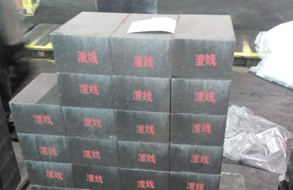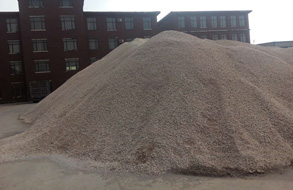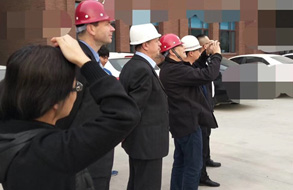Magnesia to stand firm in Q4
----Interview with Jiang Chunyong
Vice General Manager
Yingkou Guanhao Refractory Material Co., Ltd.
- Asian Metal: Thank you for accepting Asian Metal's interview. First of all, could you please briefly introduce your company from the aspects of production line, scale, capacity, output, etc?
- Mr. Jiang: Our head office Dashiqiao Huasheng Refractory Materials Co., Ltd., founded in 1984, now covers an area of 13,000 square meters, of which 5,400 square meters are the construction area. It is a specialized production company which is engaged in the businesses of mining, smelting and processing and focuses on the development and production of various kinds of high-quality fused magnesia. Our company Yingkou Guanhao Refractory Material Co., Ltd., which mainly produces high-quality fireproof magnesia carbon bricks, has attached great importance to technology and quality since its very beginning and has been qualified for importing and exporting businesses since 1997. Our company can not only produce under international standards ZBD52001-90, but also offer customized products. In order to broaden the international market, our company constantly strengthens its internal management, adjusts its product structure and provides customized products, such as ordinary sand and high calcium sand with various grain sizes.

- Our company's main businesses include two parts: raw materials and products.
- In terms of magnesia, we primarily produce fused dicalcium magnesia with 8 furnaces and have an annual capacity of 20,000t, but our monthly output of the material has decreased to 1,000t on average restrained by the supply shortage of magnesite and strict environmental inspections. In addition, we also have an annual production capacity of 25,000t of dead burned magnesia with two kilns and currently produce 2,000t of the material per month.
- As for products, we mainly produce magnesia carbon bricks with fourteen pressing machines which have an annual capacity of 30,000t.
- Asian Metal: The export quotas on magnesia were abolished in early 2017, how do you think of the changes in the export market of magnesia? And how were your company's exports in the first half of 2017?
- Mr. Jiang: During the first half of this year, the demand from overseas markets was weak owing to the depressed international economic situation. Customers consumed their existing stocks and watched the Chinese market from April to June. However, moving into the second half of this year, demand from overseas markets strengthened thanks to the rising steel prices and outputs. China's magnesia exports increased significantly during July and August mainly because panicky downstream customers increased their purchasing volumes amid production suspensions and the supply shortage in China.
- Our exports declined slightly on the whole this year. On the one hand, the demand from customers was stable. On the other hand, higher prices caused the purchasing volume to go down. We could export 1,000t of fused alumina per month on average.
- Asian Metal: What do you think are the main reasons for continuously rising magnesia prices this year?
- Mr. Jiang: There are two main causes for that: firstly, environmental protection factors; secondly, mines in Haicheng district were demanded to integrate and miners were banned from using explosives as a result of local governments' move to reinforce supervision and management, leading to a supply shortage and rising prices of magnesite. Besides, the soar in graphite electrode prices also contributed to the rises in fused magnesia prices.
- Asian Metal: Market participants generally conveyed that the quality of high-grade and high-purity & macrocrystalline fused magnesia declined noticeably this year, could you please analyze the main reasons for that and whether the decline in quality would impact the sales seriously?
- Mr. Jiang: As the high-quality and high-grade magnesite were in tight supply owing to the mining prohibition, fused magnesia producers mainly consumed their existing raw material stocks which mostly were medium or low grade to maintain production. In short, low-grade magnesite led to the decline in magnesia quality.
- However, the poor quality had no impact on sales because it was caused by poor magnesite quality. The whole market was lacking in high quality raw materials as the government banned mining in Liaoning in which high-quality magnesite is mainly concentrated. Moreover, downstream consumers had to use the low-quality raw material to maintain production. Therefore, the supply of magnesia remained short of demand.
- Asian Metal: Currently, prices for high-purity magnesia are higher than those for fused magnesia and how do you think of it?
- Mr. Jiang: I personally believe that the key reasons for that are the rising prices of raw materials amid scarce supply and irreplaceable applications of high-purity magnesia.
- Asian Metal: Currently, prices for magnesia are high and the supply of it is tight in China. What impact would that has on the global magnesia market?
- Mr. Jiang: The tight supply situation of magnesia in the Chinese market this year has seriously affected the trend of the global magnesia market. Importers turned to source the material from European countries. Currently, magnesia produced in Turkey, Netherlands and Brazil has been fully booked with prices increasing affected by the rising prices in the Chinese market.
- Asian Metal: As far as I know, your company also produces magnesium products in addition to raw materials. How much has the price increased? Does it cover the rise in raw material prices?
- Mr. Jiang: Although raw material prices have risen by as much as 300-400%, market prices for magnesia carbon bricks only increased by 30-40% on average. Domestic steel mills generally purchased magnesia carbon bricks from regular suppliers under long-term contracts, which would limit the frequency and range of the price adjustment. Additionally, steel mills strictly controlled prices from rising. As a result, it was hard for magnesium product prices to go up significantly.
- Asia Metal: Currently, the Chinese magnesia market sees a supply shortage and the continuous sharp rises in prices, which has seriously affected the global magnesium product industry as well as steel companies, how long do you think the situation would last? How do you think of the market outlook in the second half of the year?
- Mr. Jiang: We don't think the tight supply situation in the Chinese magnesia market would be greatly eased by the end of 2017 because the pressure from environmental protection remains heavy with the Chinese government's environmental protection policies unchanged in the fourth quarter. At present, taking fused magnesia as an example, prices are gradually stabilizing as they had increased sharply previously and customers are generally well equipped with stocks. Market participants largely pin their hopes on the 19th CPC National Congress, expecting that environmental inspections would be less strict after the meeting. If miners can resume mining, magnesia prices would surely start to drop. However, even if the prices of magnesia drop, they are unlikely to fall back to the level seen early this year.



